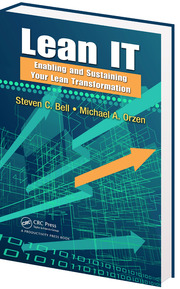 (CRC Press: Boca Raton, FL) -- An information technology (IT) organization is expected to “align with the business.” That is, IT is supposed to enable business performance and innovation, improve service levels, manage change, take advantage of emerging technologies, and maintain quality and stability, all while steadily reducing operating costs. Yet when an enterprise begins a lean transformation, too often the IT department is either left out or viewed as an obstacle. What is to be done? Lean IT: Enabling and Sustaining Your Lean Transformation by Steven C. Bell and Michael A. Orzen (CRC Press, 2010) shares practical tips, examples, and case studies to help you establish a culture of continuous improvement to deliver IT operational excellence and business value to your organization. The book is set to be released Sept. 16, 2010.
(CRC Press: Boca Raton, FL) -- An information technology (IT) organization is expected to “align with the business.” That is, IT is supposed to enable business performance and innovation, improve service levels, manage change, take advantage of emerging technologies, and maintain quality and stability, all while steadily reducing operating costs. Yet when an enterprise begins a lean transformation, too often the IT department is either left out or viewed as an obstacle. What is to be done? Lean IT: Enabling and Sustaining Your Lean Transformation by Steven C. Bell and Michael A. Orzen (CRC Press, 2010) shares practical tips, examples, and case studies to help you establish a culture of continuous improvement to deliver IT operational excellence and business value to your organization. The book is set to be released Sept. 16, 2010.
…
Add new comment